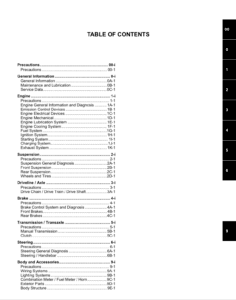Complete PDF version of the Service Manual for the Suzuki Hayabusa GSX1300R. A MUST for every Hayabusa owner.
Download: Immediately after payment!
OEM Original factory workshop manual.
Models covered by this manual: 1999 to 2007 (1st gen.)
Number of pages: 663 pages
Table of contents:

This PDF repair manual can be downloaded right after the payment process in complete, on the device of your choice.
We do not offer printed manuals, for the following reasons:
- it is more eco-friendly to use a digital version
- your manual never gets dirty or greasy
- you can always choose to print the specific page(s) you need to work on your bike
- you receive your manual immediately after payment
- it is searchable

Suzuki Hayabusa GSX1300R
Suzuki‘s GSX1300R Hayabusa is a sport bike motorbike that has been in production since 1999. With a peak speed of 303 to 312 km/h (188 to 194 mph), it quickly became known as the world’s fastest production motorbike.
Fears of a European regulatory reaction or import restriction prompted an informal agreement between Japanese and European motorcycle manufacturers in 1999 to set the top speed of their motorcycles at an arbitrary limit. The media-reported speed agreement in miles per hour was consistently 186 mph, but in kilometers per hour it ranged from 299 to 303 km/h, which is normal given unit conversion rounding mistakes. This figure, like the power and torque figures, can be influenced by a variety of external circumstances.
Because of the conditions under which this limitation was imposed, the 1999 Hayabusa’s title remained impregnable, at least theoretically, because no succeeding model could go faster without being tampered with. The Hayabusa cemented its spot as the fastest regular production bike of the twentieth century when the much-anticipated Kawasaki Ninja ZX-12R of 2000 fell 6 km/h (4 mph) short of capturing the record. Collectors will value the unrestricted 1999 models much more as a result of this.
Aside from its speed, the Hayabusa has been praised by numerous critics for its overall performance, in that it does not sacrifice other aspects such as handling, comfort, durability, noise, fuel economy, or price in order to achieve a single purpose. “If you believe the capacity of a motorbike to approach 190 mph or accomplish the quarter-mile in under 10 seconds is at best frivolous and at worst insulting, this still remains a motorcycle worthy of just consideration,” said Jay Koblenz of Motorcycle Consumer News. The Hayabusa is Speed in its purest form. But the Hayabusa is more than just speed.
First generation (1999–2007)
When the first Hayabusas were exhibited to the press in 1999, they created quite an impression. No prior motorcycle has beaten the production model top speed record by such a wide margin, ranging from 16 to 23 km/h (10 to 14 mph), depending on which recorded speeds were used for the CBR1100XX and the GSX-1300R.
Hayabusa (隼) is Japanese for “peregrine falcon,” a bird that is frequently used as a metaphor for speed because to its vertical hunting dive, or stoop, speed of 290 to 325 km/h (180 to 202 mph), which is the quickest of any bird. The name was chosen specifically because the peregrine falcon preys on blackbirds, which mirrored the original Hayabusa’s ambition to dethrone the Honda CBR1100XX Super Blackbird as the world’s fastest production motorbike. Eventually, the Hayabusa outpaced the Super Blackbird by at least 16 km/h (10 mph).
The first model was powered by a 1,299 cc (79.3 cu in) liquid-cooled inline-4 engine with sixteen valves controlled by dual-overhead camshafts. This combination, which was technologically unimpressive at the time, provided a claimed 129 kW (173 bhp) at the crankshaft thanks to the greatest displacement ever in a sport bike and a ram air system that blasted cold, pressured air into the cylinders at speed. This strong engine, combined with excellent aerodynamics, propelled the Hayabusa’s top speed much above the Honda CBR1100XX Blackbird, in contrast to the gradual advancements that preceded the Suzuki hypersport debut. The previous top speed record holder, the Kawasaki Ninja ZX-11 of 1990, had only been surpassed by the 1997 carbureted CBR1100XX.
The Hayabusa’s wealth of power at any engine speed made it simpler to ride by providing the user with a broader option of gear choices for a given speed and startling acceleration.
The ram air ducts at the front of the drooping, rounded nose pushed the frontal space away from the headlight, necessitating a stacked headlamp and high beam behind a single lens, as well as the necessity for a limited frontal area. Furthermore, the desire to lessen the severe drag experienced at high speeds drove the Hayabusa’s whole bulbous, and heavily derided, bodywork design. According to Koblenz, “the biggest criticism of the Hayabusa is its non-traditional style.” The bike’s appearance did find lovers when viewed through the perspective of individuals who rated its beauty based on its practicality, or when given a little time to grow acclimated to it.
The eye-catching two-tone brown/silver paint scheme was simultaneously adored and despised by others, but it was effective if the goal of an all-new, flagship product is to make a big statement. While some in the press referred to it as “ugly,” its aerodynamic design was critical to the Hayabusa’s capacity to attain record-breaking speeds.
In 2009, Suzuki’s Koji Yoshirua, the designer of the Hayabusa’s look, said that the goal in 1999 was “to create a somewhat grotesque design and create a strong initial impact… The mission was to create a total new styling that will not be out of date within a few years, and a styling that will be the ‘Face’ of Suzuki.” Yoshirua also stated that the goal was not to become the fastest production motorcycle, which was originally slated to be only 900 to 1,100 cc (55 to 67 cu in), but that “as a result of, pursuing the best handling, acceleration, safety, power, riding ability, original styling, etc., for the good of the customers, it became the fastest production motorcycle.” By doing so, I hoped that after the model was out on the market and its performance had been established, people would begin to exhibit interest in the unusual look, and the design would get caked in people’s minds.”
To increase chassis stiffness, the engine employed a gear-driven counterbalancer to minimize vibration to the point where the engine could be securely affixed to the frame. The Hayabusa’s handling was deemed exceptional for a bike of this class, because to its traditional twin beam frame, fully adjustable upside down forks, specially developed Bridgestone tires, and being relatively light at 215 kg (473 lb) dry. One reviewer, Koblenz, noticed a “pause and small lurch” while rolling on and off the throttle, which he attributed to inadequate low-rpm programming at low speeds.
Top speed limited by agreement
The speed war looked to be increasing in 2000, with whispers and then pre-release statements of significantly higher power in Kawasaki’s Ninja ZX-12R, plainly seeking to dethrone Suzuki and reclaim lucrative bragging rights. There were rising worries of death and mayhem from motorbikes that were getting ridiculously faster by the year, and there was talk of controlling or prohibiting the entry of super sport motorcycles into Europe.
The Japanese and European manufacturers responded with a so-called gentlemen’s agreement to electronically limit the speed of their bikes to 300 km/h (186 mph). For the 2000 model year, the informal agreement entered into full effect. So, for 2000 models and later, the question of which bike was the fastest could only be answered by tampering with the speed limiting system, which meant that it was no longer a competition between stock, production motorcycles, absolving the manufacturer of blame and allowing those who were not quite as fast to avoid losing face. Both Kawasaki and Suzuki would argue that they have the world’s quickest production motorbike, at least technically.
Other developments
After the addition of the speed limiter mechanism in 2000, the Hayabusa remained mostly unchanged until the 2007 model year. An exception was made in response to the problem of the aluminum rear subframe on 1999 and 2000 models breaking when the bike was overloaded with a passenger and luggage, and/or stressed by an aftermarket exhaust modification, so 2001 and later Hayabusas had a steel rear subframe instead of aluminum, adding 10 lb (4.5 kg) to the approximately 250 kg (550 lb) wet weight of the 1999 and 2000 models.
Source: Wikipedia
Time to get your 1st gen hayabusa + 1 service manual!

